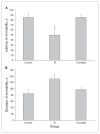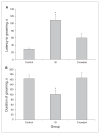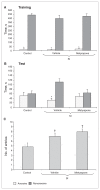Short-term social isolation induces depressive-like behaviour and reinstates the retrieval of an aversive task: mood-congruent memory in male mice?
- PMID: 23182303
- PMCID: PMC3692723
- DOI: 10.1503/jpn.120050
Short-term social isolation induces depressive-like behaviour and reinstates the retrieval of an aversive task: mood-congruent memory in male mice?
Abstract
Background: Although mood-congruent memory (MCM), or the tendency to recall information consistent with one's mood, is a robust phenomenon in human depression, to our knowledge, it has never been demonstrated in animals.
Methods: Mice were subjected to social isolation (SI) or crowding for 12 hours and had their depressive-like behaviour (evaluated by the forced swim, tail suspension, sucrose preference and splash tests) or their serum corticosterone concentrations evaluated. In addition, we determined the temporal forgetting curve of the plus-maze discriminative avoidance task (PM-DAT) and examined the effects of SI or crowding on memory retrieval in the PM-DAT. Finally, we verified the effects of metyrapone pretreatment on reinstatement of memory retrieval or on the increase of corticosterone levels induced by SI.
Results: Twelve hours of SI produced depressive-like behaviour, enhanced corticosterone concentration and reinstated retrieval of a forgotten discriminative aversive (i.e., negatively valenced) task. Depressive-like behaviour was critical for this facilitative effect of SI because 12 hours of crowding neither induced depressive-like behaviour nor enhanced retrieval, although it increased corticosterone levels at the same magnitude as SI. However, corticosterone increase was a necessary condition for MCM in mice, in that the corticosterone synthesis inhibitor metyrapone abolished SI-induced retrieval reinstatement.
Limitations: Our study did not investigate the effects of the social manipulations proposed here in a positively valenced task.
Conclusion: To our knowledge, the present paper provides the first evidence of MCM in animal models.
Figures







Similar articles
-
Short-term sleep deprivation reinstates memory retrieval in mice: the role of corticosterone secretion.Psychoneuroendocrinology. 2013 Oct;38(10):1967-78. doi: 10.1016/j.psyneuen.2013.02.016. Epub 2013 Mar 30. Psychoneuroendocrinology. 2013. PMID: 23545263
-
Mild acute stress reactivates memory of a discriminative avoidance task in mice.Stress. 2013 May;16(3):278-88. doi: 10.3109/10253890.2012.742058. Epub 2012 Dec 13. Stress. 2013. PMID: 23088427
-
Glucocorticoids mediate stress-induced impairment of retrieval of stimulus-response memory.Psychoneuroendocrinology. 2016 May;67:207-15. doi: 10.1016/j.psyneuen.2016.02.006. Epub 2016 Feb 11. Psychoneuroendocrinology. 2016. PMID: 26923851
-
[Episodic autobiographical memory in depression: a review].Encephale. 2006 Oct;32(5 Pt 1):781-8. doi: 10.1016/s0013-7006(06)76231-5. Encephale. 2006. PMID: 17099603 Review. French.
-
A meta-analytic review of mood-congruent implicit memory in depressed mood.Clin Psychol Rev. 2014 Jul;34(5):402-16. doi: 10.1016/j.cpr.2014.06.001. Epub 2014 Jun 16. Clin Psychol Rev. 2014. PMID: 24980699 Review.
Cited by
-
The type of stress matters: repeated injection and permanent social isolation stress in male mice have a differential effect on anxiety- and depressive-like behaviours, and associated biological alterations.Transl Psychiatry. 2020 Sep 21;10(1):325. doi: 10.1038/s41398-020-01000-3. Transl Psychiatry. 2020. PMID: 32958745 Free PMC article.
-
Emotion in animal contests.Proc Biol Sci. 2020 Nov 25;287(1939):20201715. doi: 10.1098/rspb.2020.1715. Epub 2020 Nov 18. Proc Biol Sci. 2020. PMID: 33203327 Free PMC article.
-
Neural mechanisms of social homeostasis.Ann N Y Acad Sci. 2019 Dec;1457(1):5-25. doi: 10.1111/nyas.14016. Epub 2019 Mar 15. Ann N Y Acad Sci. 2019. PMID: 30875095 Free PMC article. Review.
-
Rodent models of depression: neurotrophic and neuroinflammatory biomarkers.Biomed Res Int. 2014;2014:932757. doi: 10.1155/2014/932757. Epub 2014 Jun 5. Biomed Res Int. 2014. PMID: 24999483 Free PMC article. Review.
-
Trait sensitivity to stress and cognitive bias processes in fish: A brief overview.Personal Neurosci. 2024 Jan 31;7:e3. doi: 10.1017/pen.2023.14. eCollection 2024. Personal Neurosci. 2024. PMID: 38384666 Free PMC article. Review.
References
-
- McGaugh JL. Dissociating learning and performance: drug and hormone enhancement of memory storage. Brain Res Bull. 1989;23:339–45. - PubMed
-
- Wolf OT. Stress and memory in humans: Twelve years of progress? Brain Res. 2009;1293:142–54. - PubMed
-
- James W. The principles of psychology. New York (NY): Holt; 1890.
-
- Blaney PH. Affect and memory: a review. Psychol Bull. 1986;99:229–46. - PubMed
Publication types
MeSH terms
Substances
LinkOut - more resources
Full Text Sources
Other Literature Sources
Medical
